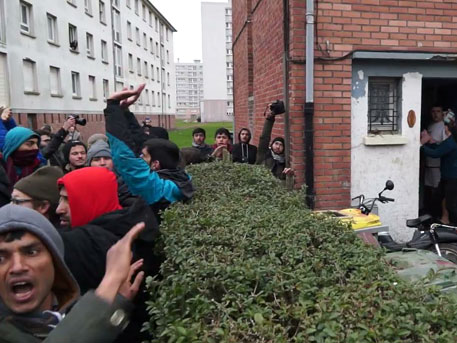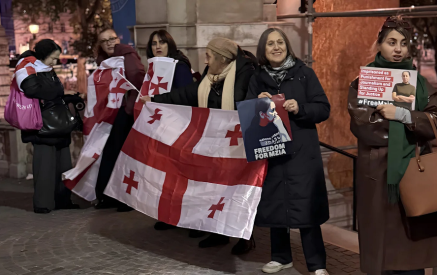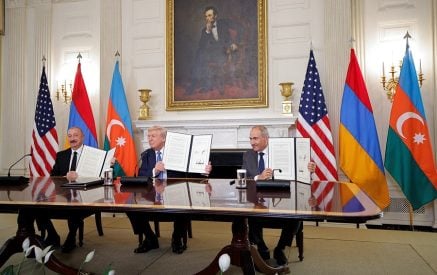Recently Russia has been carrying out active propaganda in Europe targeting the refugees. The purpose is provoking the activation of right extremist forces which “show their support” to the Russian president Vladimir Putin.
Putin’s European Fascists
It has long been known that Russian president Vladimir Putin’s policies are approved by the European far right nationalist forces. A striking example was the action held at the Italian capital in 2013, during which the Italian “National Front” movement posted posters with Putin in a military uniform and “I am with Putin” writing. Interestingly enough, the founder of the movement Adriano Tilgher started his political career with the Neo-Fascist “National Avant-Garde” movement. Later in 1990s, he was sentenced for his trial to found Mussolini’s Fascist Party again. “National Front” movement is a union of Italian radical far-right forces and, hence, it were the Italian fascists announcing that they support Putin.
The Russian president is also very popular among some layers of society in Germany. In particular, it is worth mentioning the warm welcome of the neo-Nazi faction of the Mecklenburg-Western Pomerania federal parliament to Vladimir Putin who had arrived in Germany to participate in the G8 Summit in 2007. In the letter staring with the words “Your Excellence”, the neo-Nazis were asking Putin to support the development of democracy in Germany.
Read also
Putin’s policy is also approved by the nationalist forces in France. In this case, it is the French “National Front” with its leader Marie Le Pen, who took the third place in 2012 French presidential elections. “I am happy that Putin serves as an example of determination and loyalty to the international law”. Ironically, these words belong to Marie Le Pen, leader of the French nationalist forces, who was repeatedly accused of racism and xenophobia.
Russian Lies in Europe
The migration crisis in Europe is the largest since Second World War. Europe is making enormous efforts to fight the crisis and give shelter to asylum-seekers. In fact, Europe bears quite a large part of the humanitarian consequences of military actions taking place in Near East. Notwithstanding these circumstances, the Russian propaganda machine does not miss any opportunity to arouse discontent on ethnic grounds against refugees in Europe. In this way, Russia is practically boosting the activity of the nationalist forces.
This Russian trick became obvious in the information disseminated on January 17, according to which a 13-year old Russian girl was raped by Middle Eastern refugees in Berlin. This information even made the news on the First Russian Channel as a special report. And though it soon turned out that this information was completely false, Russian migrants in Berlin started protests against Arab migrants chanting “Berlin is ours”. As a result, the German lawyer Martin Lyute appealed to the Prosecutor’s Office against the reporter of Russian Frist Channel, who, living in Berlin, sowed ethnic hatred by his report.
The Russian media never miss any opportunity to exaggerate any incident that takes place on ethnic ground in Europe. An example is the events that took place in the French city of Calais. That city is close to the Eurotunnel and there are constantly numerous migrants there who try to get to Great Britain. Recently there was a fight between refugees and locals there, and the Russian propaganda called this incident a disastrous confrontation on ethnic ground and riots.
Lately “Russia Today”, which is considered Kremlin’s Western microphone, made a publication according to which a Danish girl has been raped and the police have accused the girl who defended herself and not the rapist. There are many examples of such publications, and in case the incidents are reported by Russian media, they are strongly exaggerated or, as a rule, are obvious lies.
The Sad Experience
The dissemination of instigating misinformation against the background of the migration crisis in Europe is not the first action by the Russian propaganda machine. In July 2014, the First Russian Channel reported that the Ukrainian soldiers had crucified a three-year old boy in the Ukrainian city of Slavyansk. Later, it was proved that the video was fake. Moreover, it was revealed that the first thing the Ukrainian military units did after entering Slavyansk, was supplying residents with bread and other food. But millions of people watching the TV channel developed a hostile attitude towards the Ukrainian army. And Russians living in Ukraine started to fight against the Ukrainian army, thinking that the latter are going to come and crucify their children as well.
The Russia n propaganda machine also worked during the Russian-Georgian war in August 2008. In particular, the Russian sources, on behalf of media and agencies, reported that 1400-1600 people were killed in Tskhinvali as a result of the actions of the Georgian army. In some cases, that number reached 2100 and was called a planned genocide. However, the reality was completely different. According to the data from the Russian Prosecutor’s Office and Investigation Committee, only 133 people were killed as a result of military actions in Tskhinvali. The international human rights organizations, such as Human Rights Watch, recorded that there were only 50-60 victims in Tskhinvali. But in this case as well, the propaganda reached its aim and anti-Georgian sentiments arose in Russia, and, hence, there was public support for war.
The examples of Georgia and Ukraine show the degree the Russian propaganda is capable of. Consequently, Europe faces another challenge in conditions of the migration crisis. And it is necessary to realize that the Russian propaganda directed at neo-Nazi pro-Russian forces may have far-reaching goals, leading to disastrous consequences.
Vahe Ghukasyan
“Union of Informed Citizens”
























































